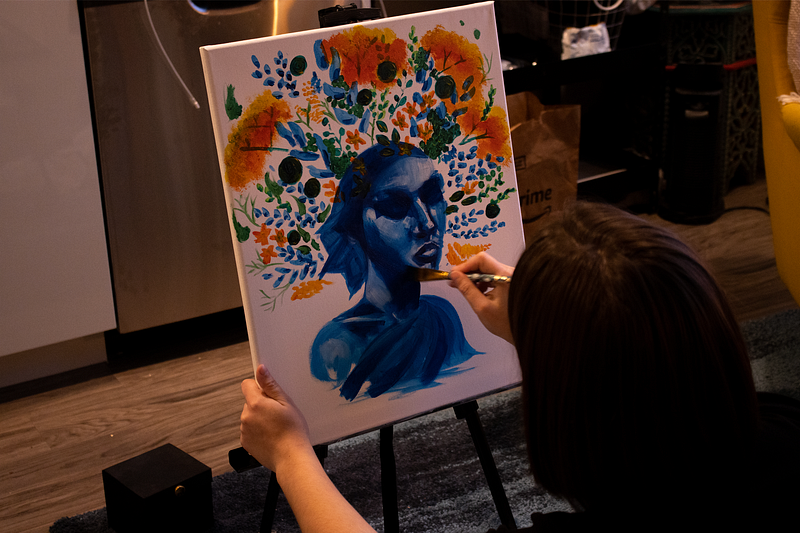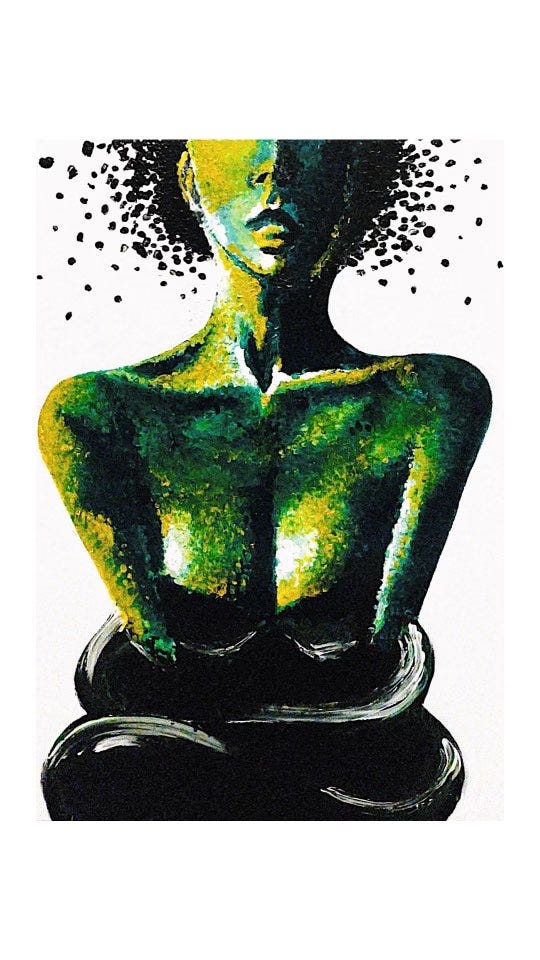A Modern Medusa

An artist connects with another survivor and finds joy in their combined strength.
Written by Noah Harper
Aiden Smith’s north Seattle studio apartment feels more like an art studio that happens to have a bed. In the center of the living room kitchen is an easel with the newest portrait under way. In the corner sits a cart with numerous brushes and acrylic paints of every color. It is reminiscent of an art classroom where the tools for creativity are ready to be used at a moment’s notice. Surrounding the painting space on every wall except the sink are paintings of giant naked women.
The canvases are towering in comparison to the smaller, hand-drawn pictures on the wall. “Orange Lady” hangs high on Aiden’s wall across from the window facing the city, allowing passersby to look up and catch a glimpse as they walk up the sidewalk.
“Orange Lady” is a vibrant piece, with its orange hues leaping off the canvas. The orange is complemented by its natural shadowing, invoking a very human feel. While only below the neck is visible, her hair pops into the frame and splinters off to fill the complementary white negative space. When you enter the room, it’s hard not to appreciate the beauty in “Orange Lady’’ and get sucked into the environment of an artist.
Aiden has been painting for most of her life, starting when she was taught by her grandmother at just 5 years old.
“My first memory painting, I was visiting my grandmother in Albuquerque,” Aiden said. “She took me to a painting class that she was doing on base.”
The smell of watercolor, a mix of musty and earthy, filled the room, recounts Aiden. As she entered the women’s art class, Aiden was instructed to paint whatever she wanted.
“I painted this face with sunflowers in it and all the old ladies were so excited,” Aiden said. “That’s what makes me happy, is to paint flowers.”
Flowers and faces make their return appearance in Aiden’s Blue People portrait series. She started the series to find more joy in painting again.
“I’m sitting there staring at this canvas thinking, just do something. And I thought, ‘Alright, you know what? I’ve never been mad about painting flowers,’” Aiden said. “I don’t feed the part of myself that needs joy enough. That series was me stepping back and saying, ‘OK, we’re just going to enjoy living life for a second.’”

Joy and painting have an interesting relationship when it comes to Aiden’s art process.
“Most of my paintings don’t start out joyful. They usually start with me really upset about something where I’m thinking, ‘OK, all I can do right now is paint.’ And then they always transform into something that I’m proud of,” Aiden said. “But it’s not a happy process.”
Often Aiden’s art comes from a place of necessity and acts almost like therapy for her, creating a very surreal experience.
“If I don’t paint, I’ll die. It’s a very real feeling,” Aiden said. “If I don’t get this out, if I don’t put this somewhere, then I have to deal with it.”
This was the case for the Giant Naked Ladies series, a series that Aiden started during the peak of quarantine in May 2020. “Orange Lady” is part of the Giant Naked Ladies series, all of which are finger painted. As Aiden began painting in May of 2020,a deeper story began to unfold across the portraits.
First came “Red Lady.” Aiden describes her as “bright and bold.” Next is Prudence, also known as “Blue Lady,” depicted as dark and deep.
Following Prudence is Medusa, or “Green Lady” followed by “Pink Lady” and finally “Orange Lady.” It was not until later that Aiden was able to perceive and unpack the deeper meanings behind the portraits.
“[The paintings] tell the story of how I dealt with grief and how I dealt with coming out of sexual assault, acknowledging that this is something that has happened to me a few times and will probably happen again,” Aiden said.
Each of Aiden’s paintings came to represent a different aspect of her grief process.
“[“Red Lady”] was saying, ‘Fuck you, I’m going to do this. I’m going to finger paint giant naked ladies,’” Aiden said. “The blue lady was realizing just how in pain I was. The green lady was anger. I was so angry.”

The Medusa
Paint-dipped fingers dance across the blank canvas, fueled by rage. As time passes, the shape of a woman begins to appear. Coiled and bound from the elbow down, her green, almost scaly skin pops from the white background. She is no ordinary green lady, she is Medusa.
“I don’t even think I planned on it being Medusa at the beginning, but she absolutely is. She’s this giant, green lady who’s pulled around with coils and has this sporadic hair,” Aiden said. “While painting her, I was able to process the pain and acknowledge the anger.”
Like the Greek myth by Ovid, the portrait shares a striking resemblance to the famous Gorgon, but Aiden’s inspiration comes with a modern twist.
The Ovid myth goes as so: Medusa was one of three Gorgons, daughter of primordial sea gods. Medusa, unlike her family members, was born a beautiful mortal. As the story goes, Medusa caught the eye of the sea god Poseidon, who raped and impregnated her in Athena’s temple.
This enraged Athena, who is a goddess of virginity, and in an act of wrath, she cursed Medusa. Her hair became snakes, and a mere glance turned mortals to stone. Medusa became a certified Greek villain in the original interpretation, eventually being slain by the hero Perseus. Medusa was punished for being raped and became a monstrous villain for centuries, instead of a victim.
This version of the myth from Metamorphoses is what most people have probably heard — it is more or less the version in the “Percy Jackson” series — but a new more nuanced version has grown popular recently, which aims to hold a history of rape culture accountable.
“Medusa was a woman who was raped. It was Athena who granted her the power to turn men to stone as a way to protect her and then placed her in this temple so that she was safe,” Aiden explained.
The change from Medusa being cursed to being gifted great power is not entirely new. Warriors’ shields were decorated with the gorgon’s head as a sign of power and protection, according to The Metropolitan Museum of Art.
Medusa has emerged as a symbol of protection and strength again in the modern day for assault survivors. Movements like “The Medusa Movement” from Colgate University use the imagery of Medusa with their mission of bringing justice to victims and to make places like college campuses safer.
The underlying themes of empowerment and survival associated with Medusa radiate from Aiden’s painting of the Gorgon and have found their way to Sammie Smith.
“She was the first person to buy a giant naked lady. She bought this painting that I was never expecting to sell,” Aiden said.
Sammie and Aiden are no strangers to each other. Starting their friendship through horseback riding as children, the pair have been friends for a long time. Sammie has also always been a fan of Aiden’s art, having bought the first painting Aiden ever listed for sale. The Medusa, however, is different.
“That painting really spoke to me,” Sammie said. “[Aiden] explained the painted ladies and how they were a way for her to reconnect with her sexual side after a sexual assault … I had my own struggles as well with sexual abuse.”
The painting became a bond between not only two friends, but two survivors.
“It made me feel good about myself and like, ’Yeah, I can actually go and do this and I’m totally fine. And I will be able to work through all my trauma,’” Sammie said. “It really was a way for me to heal and I didn’t even do the painting.”
Like the shields of warriors from the past, Medusa is a sign of strength and protection that shines on Sammie’s wall.
“It’s really beautiful to look at, and if you know the underlying meaning behind it it’s even better,” Sammie said.
In a way, the Medusa acts as a vessel for Aiden to let go of her anger, as well as being a message to women everywhere that there is hope.
“When I had someone else see it and fall in love with it and buy it for amounts of money that I didn’t know, I could sell a piece for, it allowed me to let go of that anger, to share it in a positive way,” Aiden said.
What started as a mechanism to cope with trauma has turned into a stunning piece of power and sexuality that gives joy and hope to those who understand its story.
